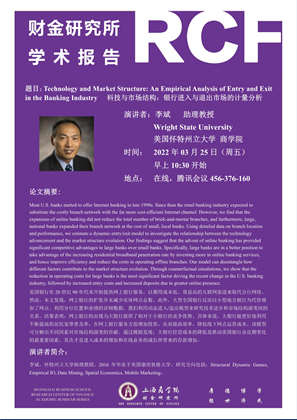通知公告
【上商学术沙龙第46讲】科技与市场结构:银行进入与退出市场的计量分析
题目:Technology and Market Structure: An Empirical Analysis of Entry and Exit in the Banking Industry
科技与市场结构:银行进入与退出市场的计量分析
演讲者:李斌 助理教授
Wright State University
美国怀特州立大学 商学院
时间: 2022年03月25日(周五)10:30
地点: 在线,腾讯会议456-376-160
内容摘要:
Most U.S. banks started to offer Internet banking in late 1990s. Since then the retail banking industry expected to substitute the costly branch network with the far more cost-efficient Internet channel. However, we find that the expansion of online banking did not reduce the total number of brick-and-mortar branches, and furthermore, large, national banks expanded their branch network at the cost of small, local banks. Using detailed data on branch location and performance, we estimate a dynamic entry/exit model to investigate the relationship between the technology advancement and the market structure evolution. Our findings suggest that the advent of online banking has provided significant competitive advantages to large banks over small banks. Specifically, large banks are in a better position to take advantage of the increasing residential broadband penetration rate by investing more in online banking services, and hence improve efficiency and reduce the costs in operating offline branches. Our model can disentangle how different factors contribute to the market structure evolution. Through counterfactual simulations, we show that the reduction in operating costs for large banks is the most significant factor driving the recent change in the U.S. banking industry, followed by increased entry costs and increased deposits due to greater online presence.
美国银行在20世纪90年代末开始提供网上银行服务,以期用成本低、效益高的互联网渠道来取代分行网络。然而,本文发现,网上银行的扩张并未减少实体网点总数,此外,大型全国银行反而以小型地方银行为代价增加了网点。利用分行位置和业绩的详细数据,我们利用动态进入/退出模型来研究技术进步和市场结构演变间的关系。结果表明:网上银行的出现为大银行提供了相对于小银行的竞争优势。具体来说,大银行能更好地利用不断提高的居民宽带普及率,在网上银行服务方面增加投资,从而提高效率,降低线下网点运营成本。该模型可分解出不同因素对市场结构演变的贡献。通过模拟发现:大银行经营成本的降低是推动美国银行业近期变化的最重要因素,其次才是进入成本的增加和在线业务的成长所带来的存款增加。
演讲者简介:
李斌,怀特州立大学助理教授,2016年毕业于美国康涅狄格大学。研究方向包括:Structural Dynamic Games, Empirical IO, Data Mining, Spatial Economics, Mobile Marketing。
